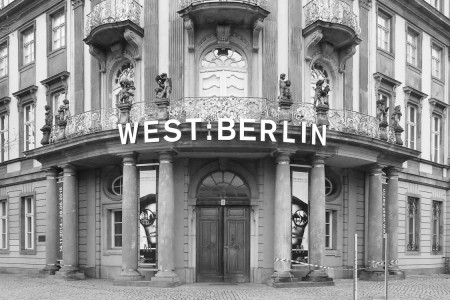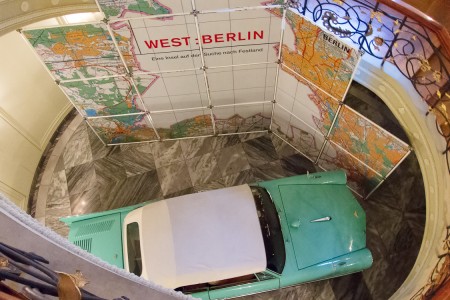
The island West Berlin formed after World War 2 and vanished by the opening of the Berlin Wall in 1989. As part of the 25th anniversary of the fall of the wall, the Stadtmuseum Berlin brings the exhibition West:Berlin – An island in search of its mainland. The exhibition introduces the new spelling West:Berlin to express its independent political view to all visitors whatever their origin: West Berliner, people from Berlin the capital of the GDR, from the FRG, from the GDR, from foreign western countries, from countries belonging to the former Warsaw Pact, or elsewhere. Interestingly, the exhibition is held in the Ephraim Palais, a beautiful exhibition space located in the former eastern part of the city. I had a look.
Ephraim Palais
In 1762, the rich banker and entrepreneur Veitel Heine Ephraim ordered to reconstruct an old pharmacy into the original Ephraim Palais, which was bought by the city of Berlin in 1843. As part of renovation plans in 1935, the Ephraim Palais was demolished to make way for the new city hall district. As the facade of the building was kept in West Berlin, and the construction drawings were left in East Berlin, the palace could not be rebuilt until 1987. In that year the Nicolaiviertel was reconstructed as part of the 750th anniversary of Berlin. After some exchanges with West Berlin, the Ephraim Palais could be rebuilt on its original location in East Berlin. Nowadays it is used for exhibitions by the Berlin Stadtmuseum, such as the current exhibition about West Berlin.
History of West Berlin
In 1945, when World War II ended, Germany was divided into a Russian, American, British and French sector. The four allied forces were supposed to form the democratic republic Germany with capital Berlin. Therefore Berlin held a special status and was divided into four sectors as well. Due to conflicting political interests, the four allied forces did not form a joint administration in Berlin. Instead they each controlled their own sector. Just a few years after the war, Berlin was the center of a new conflict: the Cold War.
In 1949 the three western sectors officially formed the city of West Berlin, a democratic society based on free elections which was closely tied to the FRG. Surrounded by the GDR, a socialistic state, West Berlin became a political enclave. As the infrastructure was cut off by the GDR (except air traffic via Tempelhof), the city was supposed to be as self-supporting as possible. Daily Berlin life went on and people could still travel throughout the entire city, East and West, go to work or visit family.
After some time, the border between East and West Germany was closed. However, because it was still easy to travel from East to West Berlin, many unsatisfied GDR citizens fled their country to West Germany via West Berlin. Between 1949 and 1961 more than 1 million people left the GDR via this escape route, until suddenly, on 13 August 1961, the wall was built by the GDR to prevent its citizens to leave. The border of the cold war became nowhere so/as near as in Berlin, and surrounded by the wall the island West Berlin became an even more unique city.
After fall of the wall in 1989 and the reunification of Germany in 1990, West Berlin lost its special status. Together with East Berlin it formed the city of Berlin, the capital of Germany. The chapter West Berlin has been history for 25 years now.
Life in West Berlin
Being an island enclosed by the socialistic GDR, West Berlin was difficult to reach. Travelling through the GDR by car along the highway was possible, but especially during border controls the GDR was not very cooperative and put up obstacles as much as possible, such as car inspections and other long procedures to increase the waiting time. Berlin was reached via the airports Tempelhof and Tegel as well, and via the Zoologischer Garten railway station, which was the only station left in West Berlin for long distance trains.
Although difficult to reach, West Berlin was an open city. Many opportunities were taken to promote the importance of freedom, especially near the wall, where for example huge loudspeakers, directed to the east, were used to propagate the free word. Dignitary had an obligatory look at the wall during official visits to West Berlin. By living at the front of the cold war, the importance of freedom and democratic rights was clearly felt. A society without these rights was just at the other side of the wall. For this reason critisism was also not easily accepted; it was suggested that you could just leave to the other side if you had complaints.
West Berlin was ruled by the three allied forces, but remained closely tied to the FRG. The West German government strongly supported the city in order to let the small society survive. The economic situation was weak as many industries were gone after World War II. Aided by the friendly economic regulations such as tax advantages there were many jobs in new mechanical and electrical industry. Furthermore scientific institutes were doing well and the fashion industry flourished.
The special status of West Berlin resulted in special regulations as well, such as the exemption from military service, special driving regulations and continuous opening hours for bars. The three allied powers each brought their own cultural values, such as art, music, literature, architecture and fairs. The booming art scene attracted many artists and the alternative scene was large.
Altogether the continuously changing population in West Berlin formed an international, creative and diverse city on a small island.

The exhibition clarifies the history of West Berlin from a political, economic, social and cultural viewpoint. It displays many photos, posters, films and attributes of the West Berlin daily life as well as of many special events.
West:Berlin – An island in search of its mainland
west.berlin
Ephraim Palais Poststrasse 16 10178 Berlin-Mitte
U2 Klosterstrasse S5 S7 S75 Alexanderplatz
Until 28 June 2015
Open Tue Thu Fri Sat Sun 10-18 Wed 12-20
Entrance 7 Euro/5 Euro, booklet included
Combiticket West:Berlin and Märkisches Museum 9 Euro/6 Euro
Under 18 free admission
First wednesday of the month free admission